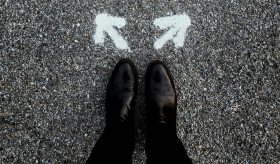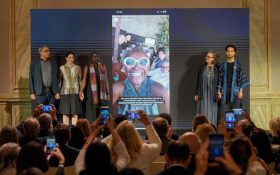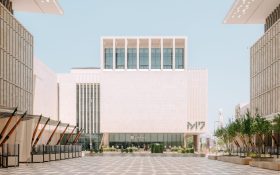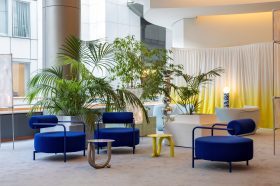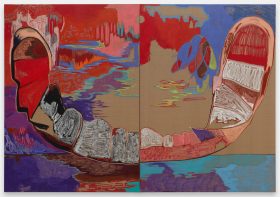Now that the photographic fair known as the Association of International Photographic Art Dealers or AIPAD occurs in April rather than February, it follows by two weeks the New York blowout weekend of art fairs, that includes the huge Armory Show, the Pulse show, the Red Dot, the Pool Art Fair at the Chelsea Hotel, and two or three others. Seeing so much art, the works have to be more and more extravagant to grab your attention, so naturally the sculptural ones tend to stand out. Then comes AIPAD, when everything is flat and mostly hanging on the wall. Passions are more subtly expressed, but they’re there among these 76 galleries.
Virtually every gallery had work that was worthy of note. Necessarily, however, I can only comment on a very small number of pieces in this article, so I will follow my intuitions, knowing there is no such thing as fairness in this business, only energy and delight.
Netherlands-based English photographer Lisa Holden’s huge, intensely colored portraits under acrylic at the Contemporary/Vintage Works Ltd. Gallery of Chalfont, PA, grabbed me immediately. The faces of her idealized women (herself, it turns out) are clear, seemingly preoccupied if not troubled, and the costumes seem to dissolve into a chaos of bright painted color. Holden billboards pixelization of her edges and other digital artifacts, which contrast sharply with the layers of paint she’s applied, in her succession of layered rephotographing to achieve her final result. Thus, she celebrates the artificiality of the digital medium as the new techno-brushstroke. It seems an obvious development, but it took creative courage to bring it off, given the prevailing Photoshop ideology of concealing the process and imitating analogue film, if not “reality.” The scale, subject matter and lushness of this work invoke Gustave Klimt’s painting, and Holden’s use of digital artifice is arguably the contemporary analogue of Klimt’s stunning but completely confected dress mosaics of 100 years ago. Holden had a good representative portfolio in the Summer 2006 issue of Eyemazing.
California-based Vietnamese photographer Binh Dahn has been extremely prolific in recent years. At AIPAD the Lisa Sette Gallery of Scottsdale, AZ, show his astonishing work using the chlorophyll of living plants to record eidetic-looking images, such as the face of a Buddha, or a butterfly, but most significantly, the faces of of his deceased countrymen, who died shortly after their pictures were taken. Dahn has obtained these precious negatives and used the slow, cumbersome process of chlorphyll-based printing, which has been known for some time, to honor their memory. The faces gazing intensely out of the many shapes of leaves—including deeply dentated palmettos—could easily pass for spiritualist evocations of shades from the Beyond. The leaf medium itself is a symbol of impermanence. He makes them by sandwiching a negative on top of a leaf clamped under glass, the stem of the leaf in a bag of water to keep it alive. After tending them for two to three weeks an image appears. He only keeps about one in five, but he’ll encase that one in resin for preservation. The effect is magical, and he creates them not only on single leaves, but on flattened sheaves of grass, where you almost think you the face you see is a hallucination.
New York-based French photographer Martine Fougeron has gained quite some success in the past two years, and deservedly so. Her work, represented by the Parisian gallery of Esther Woedehoff, manages to turn home life with her teenage children and their friends into images of concentrated beauty. All is natural, vivid without being oversaturated, inviting without being seductive, calming. They are less “about” the adolescent subjects than they are about reassuring ambience of their lives. The subjects look disarmingly at the viewer, but don’t quite invite her in. They seem unaware of the aesthetic appeal of the scene, whereas the viewer remains ignorant of what’s actually going on among the subjects caught in their ordinary lives and interactions. This creates a pleasing tension, since Fougeron has captured an “almost staged” effect, without staging anything, framing her adolescents in what appears to be a languid, protected world, that, real or not, exerts a strong nostalgic pull on the viewer.
Fifty-Seventh Street gallerist Naila Alexander has shown the work of Russian photographer Alexei Titarenko before, but this is the first time I have seen his pictures of Venice, and he applies his characteristic magic to them. As in his Russian pictures, people are often transparent, shade-like, insubstantial thanks to their movement, in contrast with the eternality of iconic buildings and monuments. But Titarenko has added the lightest touch of solarization that brightens up an area we expect to be in shadow, lending it a dreamlike quality. Even 19 years after the end of Soviet imprisonment of its citizens, it still seems incongruous for a Russian artist to be presenting any subject other than Russian ones. Yet the viscous perspectives that such a restricted soul develops, when directed elsewhere yield surprising and unaccustomed results. The facelessness of Soviet crowds becomes the insubstantiality of visitors and even rocking gondolas, set against the Canale grande: two different planes of existence.
Galerie Daniel Blau of Munich, whom I saw at Paris Photo last November, concentrates on 19th Century work, although not exclusively. Along with staid architecturals, Blau comes up with a good proportion of these vintage works that seem to overflow with bumptious personality, reminding us, in case we needed it, that people long dead were not necessarily as stogy as our grandparents. One of photographer Gustave LeGray stands out in particular. The hirsute LeGray, sits with his back against a wall, squints at the camera and pulls a cigar out of his mouth long enough to make some clever wisecrack, or so it seems. This takes place in 1854, and his friend A. Delaunay was there to trip his shutter. Also remarkable in Blau’s collection was George Sommer’s 1880s series on the plaster casts made in the shape of bodies vaporized by the superheated lava of Vesuvius in the Pompeii eruption. You can still see these casts when you visit Pompeii, but it’s good to be reminded that earlier generations felt the same frisson we feel.
The Czech Center of Photography is one of my favorite perennial stops at AIPAD. Their booth always treats us to the rich history of Czech photography, whose purveyors have always seemed to eat, sleep, and make love to the avant-garde. Tendencies in the early 1920s to “poeticize” Russian Constructivism (Poetism was a self-conscious movement let by professedly anti-bourgeois photographer Karel Teige [1900-51], encourage experimentation and embrace various forms of modernism with its mass appeal, gave Czech photography a distinct national stamp, sending it in a direction that prefigured surrealism, which it then heartily embraced. This first movement of Czech photography, exemplified by the work of photographers such as Jaroslav Rössler, Jaromir Funke, Frantisek Dritikol and the somewhat better known Josef Sudek, was characterized by the use of dramatic shadows, oblique angles on close-ups of objects, multiple exposure, distortion, especially of the figure, and the refraction of light through wet, fogged or iced glass. Under Socialism, Czech photographers still managed to produce aesthetically and socially enduring work, including Josef Koudelka’s gypsy series and Markéta Luskacová’s Christian pilgrims. But Czech photographers never wavered in their boldness and creativity. However, after the fall of communism there, aka the Velvet Revolution, much more of this work has gotten out, and names like Tony Stano with his graphic nudes, Jan Saudek with his hand-colored bizarrely erotic staged photography, and Michal Mackù with his head-annihilating mordençages, have acquired wider recognition. The Czech Center’s AIPAD booth is the portal to all of these and more.
In the land of the Flat the Free-Standing is king, but in this case the free-standing silk woven screen by Robert Glenn Ketchum at Peter Wach’s gallery stand (Avon Lake, Ohio) had me completely transfixed. Ketchum has made a career of extravagantly beautiful landscape photography, including some breathtaking aerials of Alaskan waterways, that are on his website. Here, however, he confronts the problem of making new again the exquisite but by now banal patterns of bare tree branches and wetland reeds by copying his photograph into a three-panal fine threaded, translucent silken screen. Photographs into paintings—paintings into tapestries—this one goes one step farther in its delicacy and shimmer, and the effect is stunning.
Add two more artists to the exclusive roster of those who stage wacky and impossible scientific experiments—one thinks immediately of Robert and Shana Parkeharrison (represented at AIPAD by Catherine Edelman of Chicago). The first is the husband and wife team of (Jeff) Louvière and Vanessa (Brown), based in New Orleans, so displayed appropriately in Joshua Mann Paillet’s A Gallery for Fine Photography. “Scientific” might be a slight stretch for them, morphing quickly into the imaginatively obsessive and dreamlike. Their signature image is Chloroformina Loup Garou, (the Cajun boogie man), a grass-skirted man masked in some sort of modified leaf with a curved prehensile snout, plodding across a field on vegetal stilts, obsessively intent on some undefined quest. The image is brown toned with wax and blood, which lends it a fictitious age and mock seriousness. Others include Equilibrium, a standing bound man viewed from above with teathered spheres swirling around his head; The Tyranny of the Innocent, a groom (?) in a black suit carrying his unconscious bride through a field of tall reeds, with the frame excluding his face.
The other is more squarely pseudo-scientific: Hirsch Perlman’s “document” of the fanciful night launching of a wood-and-paper rocket at the Robert Miller Gallery of New York. The series is entitled in fake Latin, Apparatum Armorum Ineptum. We see the projectile in the glow of its burning fuel, just as it lifts off, away from the 10-foot step ladder, and bursting the paper strips that had propped it up. The moon and sky glow in the distance. In another image it has reached the height of 10 feet, almost above the ladder, incandescent from inside its fuselage, almost believable.
Serge Plantureux of Paris cuts an enigmatic figure, always appearing younger than I remember him, a visionary immersed in 19th century photo history, spinning it out its secrets to willing listeners, and self publishing an exceptional array of catalogues, initially to introduce these works to prospective collectors, but increasingly dominated by the small format (ca. 5×5.5 in) hard-cover booklets compiled by his apprentices and employees treating some bizarre and neglected aspect of photography. This year I picked up a compilation of collages made by French first graders who cut up and added their own graphic figures to well-known Henri Cartier-Bresson photographs. On the surface an in-your-face defacing of works of the Master, adding, for example, crude line drawings of figures added to “play” with the photographed people in the scene; but it operates to subvert the layers of pious interpretation that have encrusted these works, and one senses HCB would have greeted it with a wink and a laugh. Plantureux’s mute smile is implicit in the book’s epigraph quoting the creator of Images à la sauvette with head-spinning context shift: “Il n’y a pas d’hasard,” (“Nothing is random.”).
This is but a small sampling of the beauty and richness AIPAD offered this year. If ever you do go—to this or any other fine art photography fair, it’s wise to leave enough time for the gallery owners to show you more and explain the history and significance of the works they have, since this is the art form that offers the clearest window on the world outside of itself.
